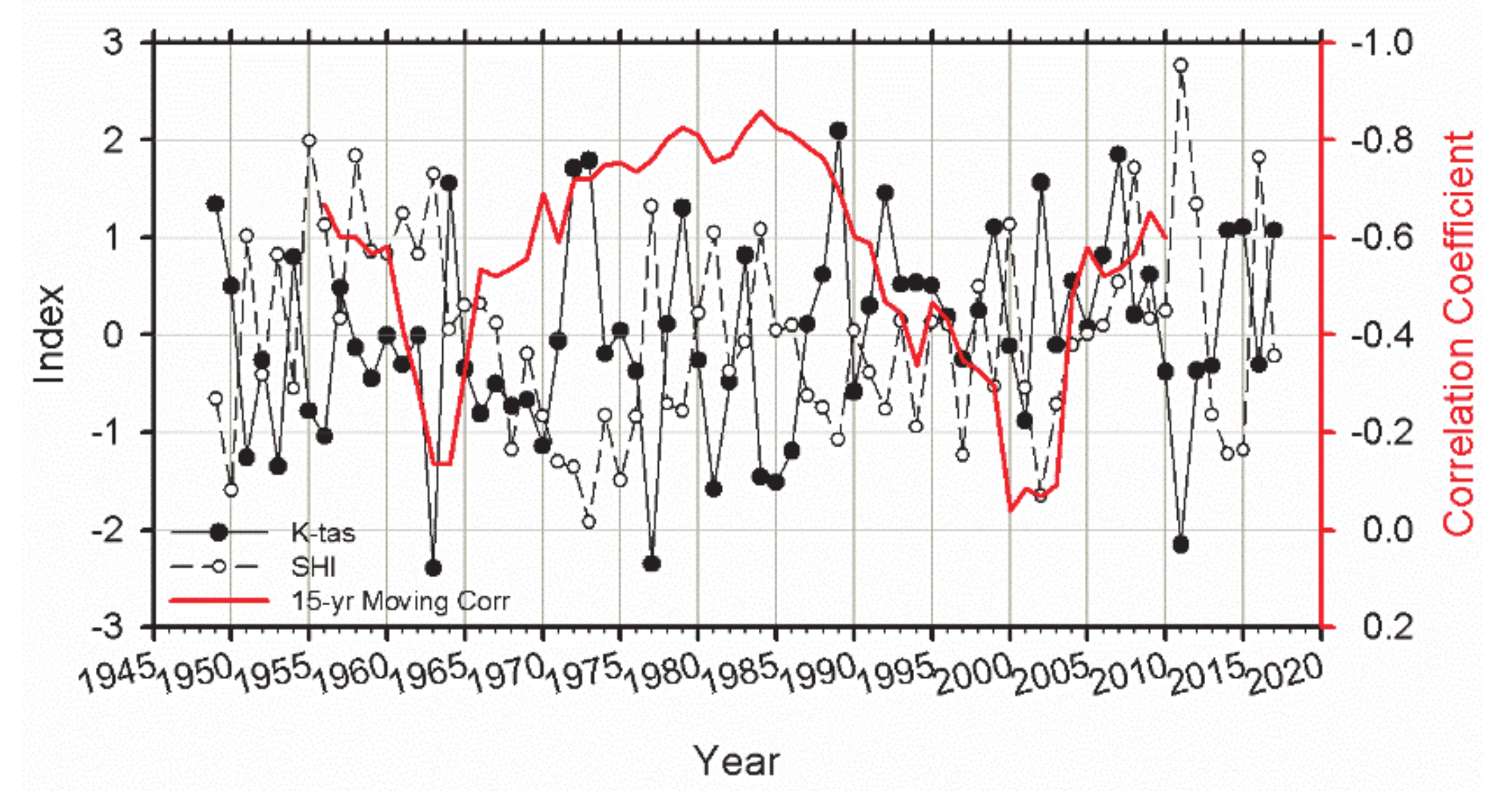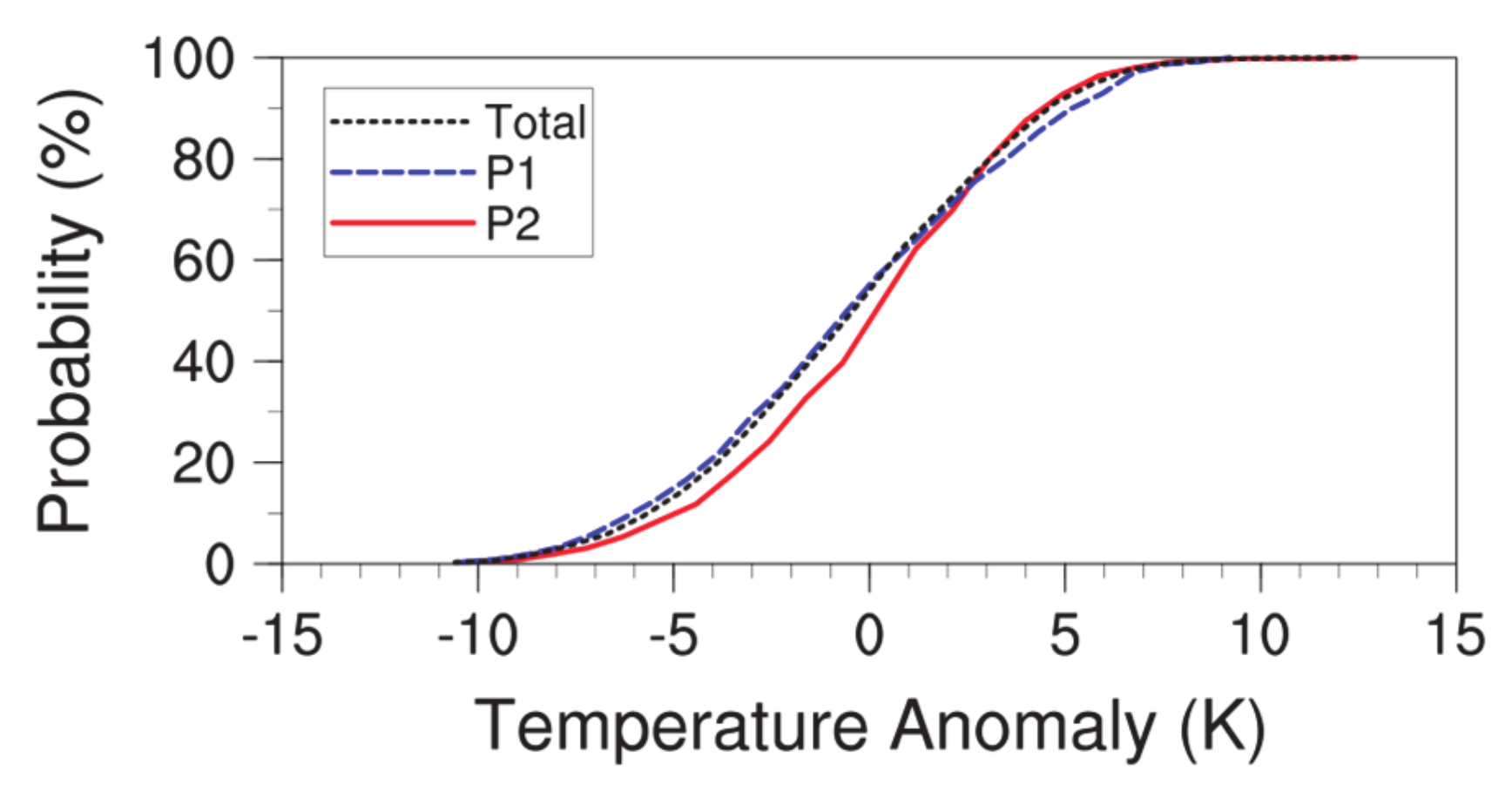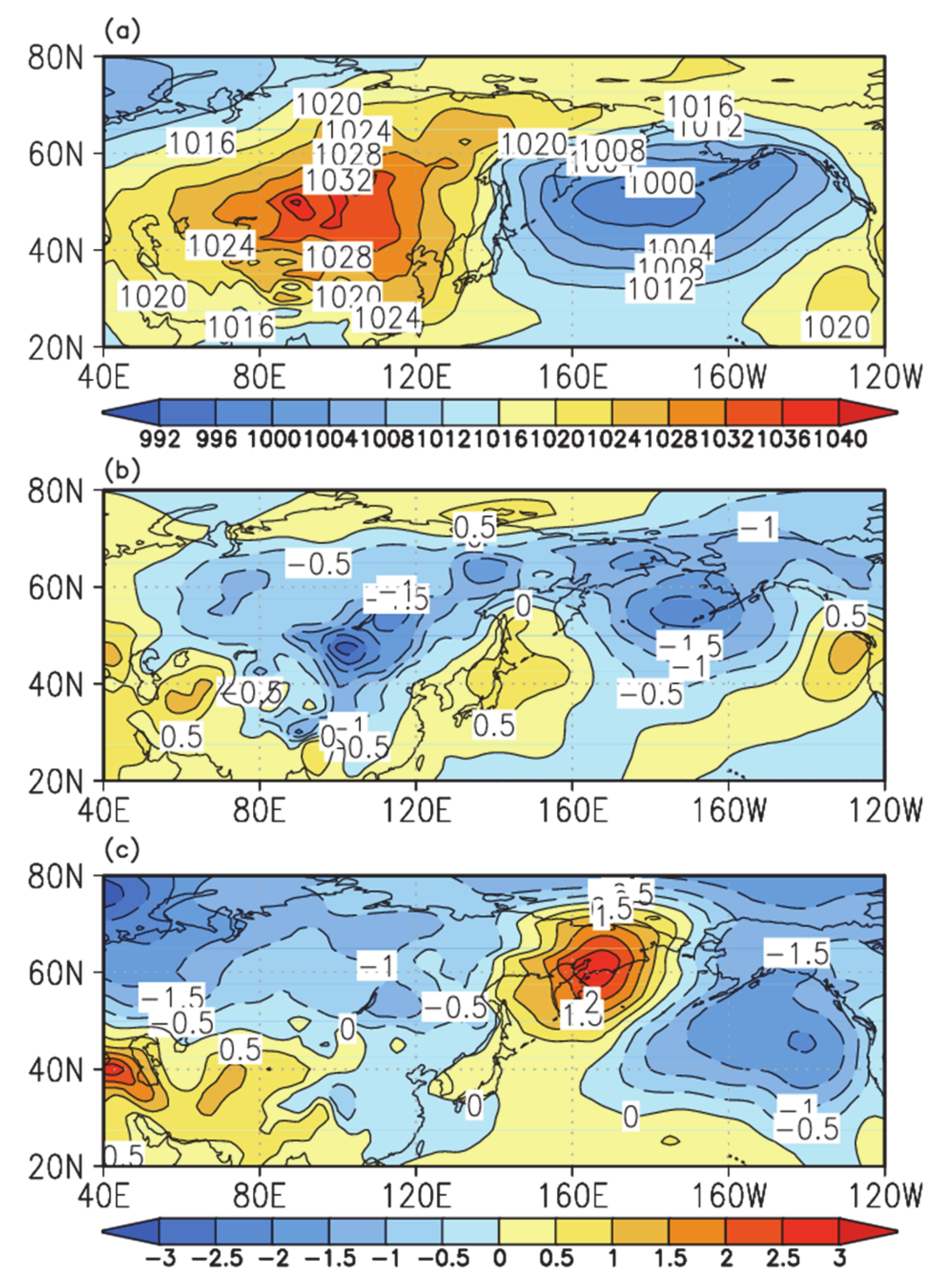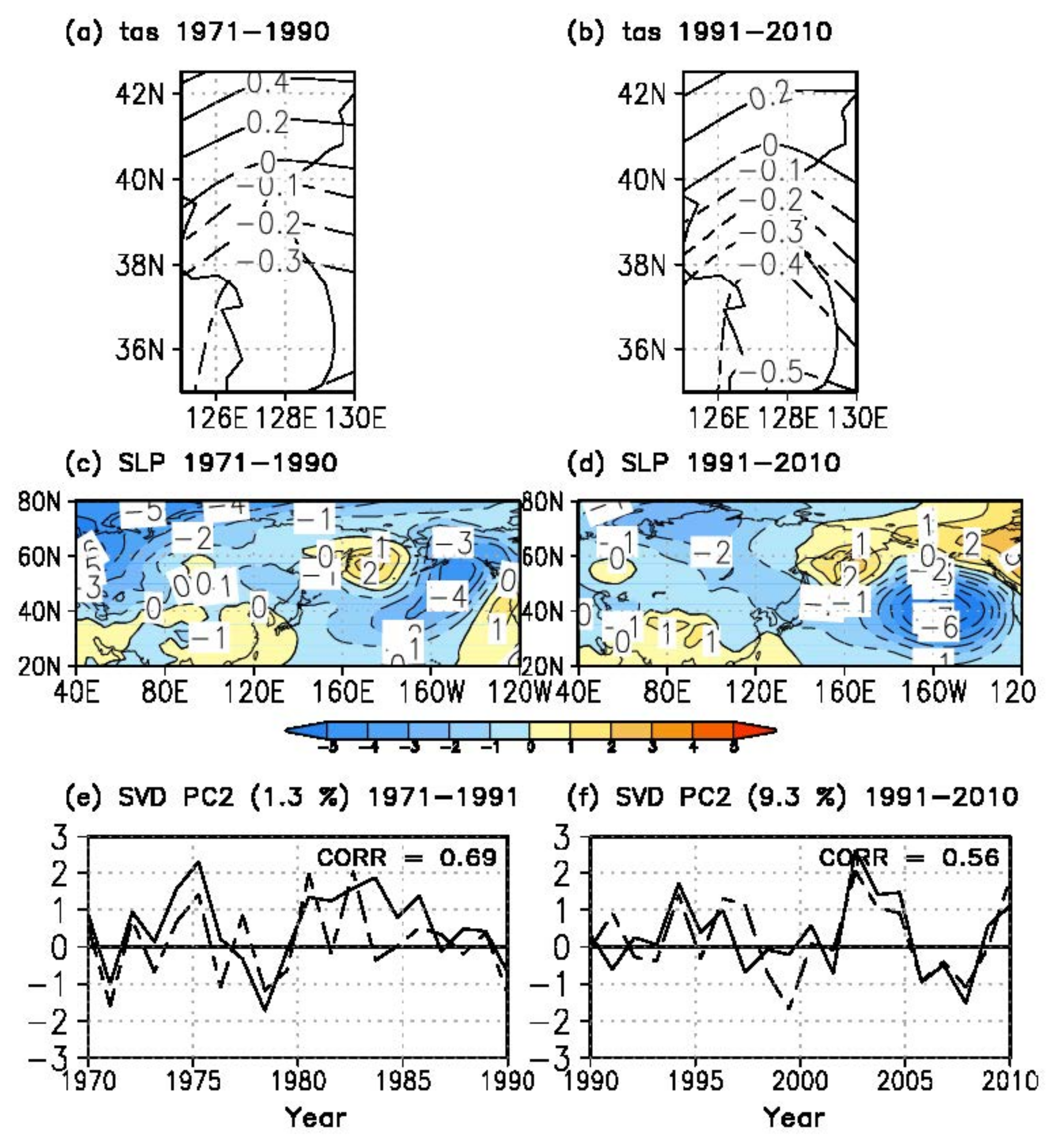Non-Stationary Effects of the Arctic Oscillation and El Niño–Southern Oscillation on January Temperatures in Korea
Abstract
1. Introduction
2. Data and Methods
3. Results
3.1. Correlation between the Winter Temperature in Korea and SH
3.2. Time-Mean Anomaly Pattern of Temperature and Mean Sea-Level Pressure
3.3. Large-Scale Circulation around Korea
3.3.1. Surface Air Temperature and Mean Sea-Level Pressure
3.3.2. Geopotential Height at 300 hPa
4. Summary and Conclusions
Author Contributions
Funding
Institutional Review Board Statement
Informed Consent Statement
Data Availability Statement
Acknowledgments
Conflicts of Interest
References
- Lu, C.; Xie, S.; Qin, Y.; Zhou, J. Recent Intensified Winter Coldness in the Mid-High Latitudes of Eurasia and Its Relationship with Daily Extreme Low Temperature Variability. Adv. Meteorol. 2016, 2016, 17–19. [Google Scholar] [CrossRef]
- Overland, J.E.; Wood, K.R.; Wang, M. Warm Arctic-cold continents: Climate impacts of the newly open arctic sea. Polar Res. 2011, 30. [Google Scholar] [CrossRef]
- Francis, J.; Skific, N. Evidence linking rapid Arctic warming to mid-latitude weather patterns. Philos. Trans. A Math. Phys. Eng. Sci. 2015, 373. [Google Scholar] [CrossRef]
- Cohen, J.; Pfeiffer, K.; Francis, J.A. Warm Arctic episodes linked with increased frequency of extreme winter weather in the United States. Nat. Commun. 2018, 9, 1–12. [Google Scholar] [CrossRef] [PubMed]
- Johnson, N.C.; Xie, S.P.; Kosaka, Y.; Li, X. Increasing occurrence of cold and warm extremes during the recent global warming slowdown. Nat. Commun. 2018, 9, 4–6. [Google Scholar] [CrossRef] [PubMed]
- Kim, Y.H.; Kim, M.K.; Lau, W.K.M.; Kim, K.M.; Cho, C.H. Possible mechanism of abrupt jump in winter surface air temperature in the late 1980s over the Northern Hemisphere. J. Geophys. Res. 2015, 120, 12474–12485. [Google Scholar] [CrossRef] [PubMed]
- Li, C.; Stevens, B.; Marotzke, J. Eurasian winter cooling in the warming hiatus of 1998–2012. Geophys. Res. Lett. 2015, 42, 8131–8139. [Google Scholar] [CrossRef]
- Sun, L.; Perlwitz, J.; Hoerling, M. What caused the recent “Warm Arctic, Cold Continents” trend pattern in winter temperatures? Geophys. Res. Lett. 2016, 43, 5345–5352. [Google Scholar] [CrossRef]
- Roy, I. Solar cyclic variability can modulate winter Arctic climate. Sci. Rep. 2018, 8, 1–15. [Google Scholar] [CrossRef]
- Cohen, J.; Jones, J.; Furtado, J.C.; Tziperman, E. Warm Arctic, cold continents a common pattern related to Arctic sea ice melt, snow advance, and extreme winter weather. Oceanography 2013, 26, 150–160. [Google Scholar] [CrossRef]
- Luo, D.; Xiao, Y.; Diao, Y.; Dai, A.; Franzke, C.L.E.; Simmonds, I. Impact of Ural blocking on winter warm Arctic-cold Eurasian anomalies. Part II: The link to the North Atlantic Oscillation. J. Clim. 2016, 29, 3949–3971. [Google Scholar] [CrossRef]
- Xu, X.; He, S.; Li, F.; Wang, H. Impact of northern Eurasian snow cover in autumn on the warm Arctic–cold Eurasia pattern during the following January and its linkage to stationary planetary waves. Clim. Dyn. 2018, 50, 1993–2006. [Google Scholar] [CrossRef]
- Cao, Y.; Liang, S.; Yu, M. Observed low-frequency linkage between Northern Hemisphere tropical expansion and polar vortex weakening from 1979 to 2012. Atmos. Res. 2020, 243, 105034. [Google Scholar] [CrossRef]
- Shi, J.; Cui, L.; Ma, Y.; Du, H.; Wen, K. Trends in temperature extremes and their association with circulation patterns in China during 1961–2015. Atmos. Res. 2018, 212, 259–272. [Google Scholar] [CrossRef]
- Sung, M.K.; Kim, S.H.; Kim, B.M.; Choi, Y.S. Interdecadal variability of the warm Arctic and cold Eurasia pattern and its North Atlantic origin. J. Clim. 2018, 31, 5793–5810. [Google Scholar] [CrossRef]
- Yu, L.; Zhong, S.; Sui, C.; Sun, B. Revisiting the trend in the occurrences of the warm Arctic-cold Eurasian continent temperature pattern. Atmos. Chem. Phys. 2020, 1–48. [Google Scholar] [CrossRef]
- Jhun, J.G.; Lee, E.J. A new East Asian winter monsoon index and associated characteristics of the winter monsoon. J. Clim. 2004, 17, 711–726. [Google Scholar] [CrossRef]
- Zhang, Y.; Sperber, K.R.; Boyle, J.S. Climatology and Interannual Variation of the East Asian Winter Monsoon: Results from the 1979–95 NCEP/NCAR Reanalysis. Mon. Weather Rev. 1997, 125, 2605–2619. [Google Scholar] [CrossRef]
- Gong, D.Y.; Ho, C.H. The Siberian High and climate change over middle to high latitude Asia. Theor. Appl. Climatol. 2002, 72, 1–9. [Google Scholar] [CrossRef]
- Gong, D.Y.; Wang, S.W.; Zhu, J.H. East Asian winter monsoon and Arctic Oscillation. Geophys. Res. Lett. 2001, 28, 2073–2076. [Google Scholar] [CrossRef]
- Wu, B.; Wang, J. Winter Arctic Oscillation, Siberian High and East Asian Winter Monsoon. Geophys. Res. Lett. 2002, 29, 3–6. [Google Scholar] [CrossRef]
- Roy, I. Addressing on Abrupt Global Warming, Warming Trend Slowdown and Related Features in Recent Decades. Front. Earth Sci. 2018, 6, 1–19. [Google Scholar] [CrossRef]
- Jun, Y.; Song, K.; Son, S. Decadal Changes in the Relationship between Arctic Oscillation and Surface Air Temperature over Korea. Atmosphere 2021, 31, 61–71. [Google Scholar]
- Chen, W.; Lan, X.Q.; Wang, L.; Ma, Y. The combined effects of the ENSO and the Arctic Oscillation on the winter climate anomalies in East Asia. Chinese Sci. Bull. 2013, 58, 1355–1362. [Google Scholar] [CrossRef]
- Cheung, H.N.; Zhou, W.; Mok, H.Y.; Wu, M.C. Relationship between Ural-Siberian Blocking and the East Asian winter monsoon in relation to the Arctic oscillation and the El Niño-Southern Oscillation. J. Clim. 2012, 25, 4242–4257. [Google Scholar] [CrossRef]
- Wang, L.; Chen, W.; Huang, R. Interdecadal modulation of PDO on the impact of ENSO on the east Asian winter monsoon. Geophys. Res. Lett. 2008, 35, 1–4. [Google Scholar] [CrossRef]
- Gong, H.; Wang, L.; Chen, W. Multidecadal changes in the influence of the arctic oscillation on the east asian surface air temperature in boreal winter. Atmosphere 2019, 10, 757. [Google Scholar] [CrossRef]
- Gong, H.; Wang, L.; Chen, W. Recently strengthened influence of ENSO on the Wintertime East Asian surface air temperature. Atmosphere 2019, 10, 720. [Google Scholar] [CrossRef]
- Yun, K.S.; Seo, Y.W.; Ha, K.J.; Lee, J.Y.; Kajikawa, Y. Interdecadal changes in the Asian winter monsoon variability and its relationship with ENSO and AO. Asia-Pacific J. Atmos. Sci. 2014, 50, 531–540. [Google Scholar] [CrossRef]
- Yun, J.; Ha, K.J.; Jo, Y.H. Interdecadal changes in winter surface air temperature over East Asia and their possible causes. Clim. Dyn. 2017, 51, 1375–1390. [Google Scholar] [CrossRef]
- Chen, S.; Song, L. Recent strengthened impact of the winter Arctic Oscillation on the Southeast Asian surface air temperature variation. Atmosphere 2019, 10, 164. [Google Scholar] [CrossRef]
- He, S. Reduction of the East Asian winter monsoon interannual variability after the mid-1980s and possible cause. Chinese Sci. Bull. 2013, 58, 1331–1338. [Google Scholar] [CrossRef]
- Kim, J.W.; An, S. Il; Jun, S.Y.; Park, H.J.; Yeh, S.W. ENSO and East Asian winter monsoon relationship modulation associated with the anomalous northwest Pacific anticyclone. Clim. Dyn. 2017, 49, 1157–1179. [Google Scholar] [CrossRef]
- Lee, S.S.; Kim, S.H.; Jhun, J.G.; Ha, K.J.; Seo, Y.W. Robust warming over East Asia during the boreal winter monsoon and its possible causes. Environ. Res. Lett. 2013, 8. [Google Scholar] [CrossRef]
- Wang, H.J.; He, S.P. Weakening relationship between East Asian winter monsoon and ENSO after mid-1970s. Chin. Sci. Bull. 2012, 57, 3535–3540. [Google Scholar] [CrossRef]
- Yang, L.N.; Wu, B.Y. Interdecadal variations of the East Asian winter surface air temperature and possible causes. Chin. Sci. Bull. 2013, 58, 3969–3977. [Google Scholar] [CrossRef]
- Wang, H.; He, S.; Liu, J. Present and future relationship between the East Asian winter monsoon and ENSO: Results of CMIP5. J. Geophys. Res. Ocean. 2013, 118, 5222–5237. [Google Scholar] [CrossRef]
- Kalnay, E.; Collins, W.; Deaven, D.; Gandin, L.; Iredell, M.; Jenne, R.; Joseph, D. The NCEP_NCAR 40-year reanalysis project. 1996.pdf. Bull. Am. Meteorol. Soc. 1996, 77, 437–472. [Google Scholar] [CrossRef]
- Lee, H.S.; Jhun, J.G. Two types of a Asian continental blocking and their relation to the east Asian monsoon during the boreal winter. Geophys. Res. Lett. 2006, 33, 1–5. [Google Scholar] [CrossRef]
- Thompson, D.W.J.; Wallace, J.M. The Arctic oscillation signature in the wintertime geopotential height and temperature fields. Geophys. Res. Lett. 1998, 25, 1297–1300. [Google Scholar] [CrossRef]
- Trenberth, K.E.; Hurrell, J.W. Decadal atmosphere-ocean variations in the Pacific. Clim. Dyn. 1994, 9, 303–319. [Google Scholar] [CrossRef]
- Trenberth, K.E. The Definition of El Niño. Bull. Am. Meteorol. Soc. 1997, 78, 2771–2777. [Google Scholar] [CrossRef]
- Venegas, S.A.; Mysak, L.A.; Straub, D.N. Atmosphere-ocean coupled variability in the South Atlantic. J. Clim. 1997, 10, 2904–2920. [Google Scholar] [CrossRef]
- Jeong, Y.K.; Renwick, J.A. Locations of the Siberian high centers of action and associated propagation of wave-like patterns in the northern hemisphere winter. Asia Pac. J. Atmos. Sci. 2008, 44, 149–171. [Google Scholar]
- Park, T.W.; Ho, C.H.; Deng, Y. A synoptic and dynamical characterization of wave-train and blocking cold surge over East Asia. Clim. Dyn. 2014, 43, 753–770. [Google Scholar] [CrossRef]
- Park, T.-W.; Ho, C.-H.; Jeong, J.-H.; Heo, J.-W.; Deng, Y. A new dynamical index for classification of cold surge types over East Asia. Clim. Dyn. 2015, 45, 2469–2484. [Google Scholar] [CrossRef]
- Huang, W.; Wang, B.; Wright, J.S.; Chen, R. On the Non-Stationary Relationship between the Siberian High and Arctic Oscillation. PLoS ONE 2016, 11, e0158122. [Google Scholar] [CrossRef]
- Dosio, A.; Fischer, E.M. Will Half a Degree Make a Difference? Robust Projections of Indices of Mean and Extreme Climate in Europe Under 1.5°C, 2°C, and 3°C Global Warming. Geophys. Res. Lett. 2018, 45, 935–944. [Google Scholar] [CrossRef]
- Thompson, D.W.J.; Wallace, J.M. Annular modes in the extratropical circulation. Part I: Month-to-month variability. J. Clim. 2000, 13, 1000–1016. [Google Scholar] [CrossRef]
- Yeh, S.W.; Yi, D.W.; Sung, M.K.; Kim, Y.H. An Eastward Shift of the North Pacific Oscillation After the mid-1990s and Its Relationship with ENSO. Geophys. Res. Lett. 2018, 45, 6654–6660. [Google Scholar] [CrossRef]
- Chhak, K.; Di Lorenzo, E. Decadal variations in the California Current upwelling cells. Geophys. Res. Lett. 2007, 34, 1–6. [Google Scholar] [CrossRef]
- Linkin, M.E.; Nigam, S. The North Pacific Oscillation-West Pacific teleconnection pattern: Mature-phase structure and winter impacts. J. Clim. 2008, 21, 1979–1997. [Google Scholar] [CrossRef]
- Papineau, J.M. Wintertime temperature anomalies in Alaska correlated with ENSO and PDO. Int. J. Climatol. 2001, 21, 1577–1592. [Google Scholar] [CrossRef]









| SHI | AO | Nino3.4 |
|---|---|---|
| 1949–2017 | −0.33 * | 0.02 |
| 1971–1990 | −0.43 | 0.13 |
| 1991–2010 | −0.03 | −0.17 |
| ALI | AO | Nino3.4 |
|---|---|---|
| 1949–2017 | 0.33 * | −0.46 * |
| 1971–1990 | 0.40 | −0.31 |
| 1991–2010 | 0.43 | −0.70 * |
Publisher’s Note: MDPI stays neutral with regard to jurisdictional claims in published maps and institutional affiliations. |
© 2021 by the authors. Licensee MDPI, Basel, Switzerland. This article is an open access article distributed under the terms and conditions of the Creative Commons Attribution (CC BY) license (https://creativecommons.org/licenses/by/4.0/).
Share and Cite
Yoon, J.-S.; Chung, I.-U.; Shin, H.-J.; Jang, K.-Y.; Kim, M.-K.; Park, J.-S.; Park, D.-S.R.; Boo, K.-O.; Byun, Y.-H.; Sung, H.-M. Non-Stationary Effects of the Arctic Oscillation and El Niño–Southern Oscillation on January Temperatures in Korea. Atmosphere 2021, 12, 538. https://doi.org/10.3390/atmos12050538
Yoon J-S, Chung I-U, Shin H-J, Jang K-Y, Kim M-K, Park J-S, Park D-SR, Boo K-O, Byun Y-H, Sung H-M. Non-Stationary Effects of the Arctic Oscillation and El Niño–Southern Oscillation on January Temperatures in Korea. Atmosphere. 2021; 12(5):538. https://doi.org/10.3390/atmos12050538
Chicago/Turabian StyleYoon, Jae-Seung, Il-Ung Chung, Ho-Jeong Shin, Kunmn-Yeong Jang, Maeng-Ki Kim, Jeong-Soo Park, Doo-Sun R. Park, Kyung-On Boo, Young-Hwa Byun, and Hyun-Min Sung. 2021. "Non-Stationary Effects of the Arctic Oscillation and El Niño–Southern Oscillation on January Temperatures in Korea" Atmosphere 12, no. 5: 538. https://doi.org/10.3390/atmos12050538
APA StyleYoon, J.-S., Chung, I.-U., Shin, H.-J., Jang, K.-Y., Kim, M.-K., Park, J.-S., Park, D.-S. R., Boo, K.-O., Byun, Y.-H., & Sung, H.-M. (2021). Non-Stationary Effects of the Arctic Oscillation and El Niño–Southern Oscillation on January Temperatures in Korea. Atmosphere, 12(5), 538. https://doi.org/10.3390/atmos12050538







